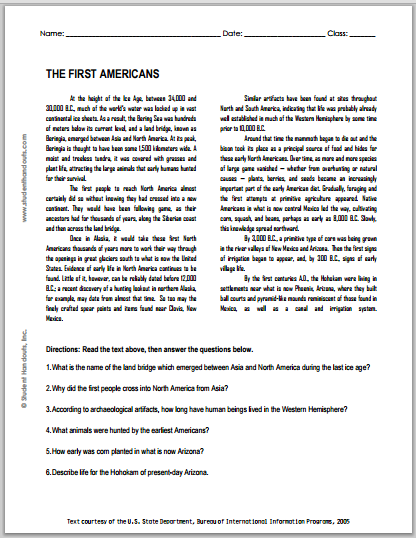| The First Americans Reading with Questions |
| www.studenthandouts.com ↣ American History ↣ American History Readings |
 At the height of the Ice Age, between 34,000 and 30,000 B.C.E., much of the world's water was locked up in vast continental ice sheets. As a result, the Bering Sea was hundreds of meters below its current level, and a land bridge, known as Beringia, emerged between Asia and North America. At its peak, Beringia is thought to have been some 1,500 kilometers wide. A moist and treeless tundra, it was covered with grasses and plant life, attracting the large animals that early humans hunted for their survival.
At the height of the Ice Age, between 34,000 and 30,000 B.C.E., much of the world's water was locked up in vast continental ice sheets. As a result, the Bering Sea was hundreds of meters below its current level, and a land bridge, known as Beringia, emerged between Asia and North America. At its peak, Beringia is thought to have been some 1,500 kilometers wide. A moist and treeless tundra, it was covered with grasses and plant life, attracting the large animals that early humans hunted for their survival.The first people to reach North America almost certainly did so without knowing they had crossed into a new continent. They would have been following game, as their ancestors had for thousands of years, along the Siberian coast and then across the land bridge. Once in Alaska, it would take these first North Americans thousands of years more to work their way through the openings in great glaciers south to what is now the United States. Evidence of early life in North America continues to be found. Little of it, however, can be reliably dated before 12,000 B.C.E.; a recent discovery of a hunting lookout in northern Alaska, for example, may date from almost that time. So too may the finely crafted spear points and items found near Clovis, New Mexico. Similar artifacts have been found at sites throughout North and South America, indicating that life was probably already well established in much of the Western Hemisphere by some time prior to 10,000 B.C.E. Around that time the mammoth began to die out and the bison took its place as a principal source of food and hides for these early North Americans. Over time, as more and more species of large game vanished—whether from overhunting or natural causes—plants, berries, and seeds became an increasingly important part of the early American diet. Gradually, foraging and the first attempts at primitive agriculture appeared. Native Americans in what is now central Mexico led the way, cultivating corn, squash, and beans, perhaps as early as 8,000 B.C.E. Slowly, this knowledge spread northward. By 3,000 B.C.E., a primitive type of corn was being grown in the river valleys of New Mexico and Arizona. Then the first signs of irrigation began to appear, and, by 300 B.C.E., signs of early village life. By the first centuries A.D., the Hohokam were living in settlements near what is now Phoenix, Arizona, where they built ball courts and pyramid-like mounds reminiscent of those found in Mexico, as well as a canal and irrigation system. |
|
Directions: Read the text above, then answer the questions below. 1. What is the name of the land bridge which emerged between Asia and North America during the last ice age? Beringia 2. Why did the first people cross into North America from Asia? Chasing wild game 3. According to archaeological artifacts, how long have human beings lived in the Western Hemisphere? Since 12000 B.C.E. 4. What animals were hunted by the earliest Americans? Mammoth and bison 5. How early was corn planted in what is now Arizona? 3000 B.C.E. 6. Describe life for the Hohokam of present-day Arizona. Hohokam were living in settlements near what is now Phoenix, Arizona, where they built ball courts and pyramid-like mounds reminiscent of those found in Mexico, as well as a canal and irrigation system. |
| Click here to print this worksheet. |
 |
 |
 |
 |
 |
 |
| Early America Books and Films | Early America Image Galleries |
| Early America Learning and Study Games | Early America Miscellany |
| Early America Outlines and PowerPoints | Early America Worksheets |
| www.studenthandouts.com ↣ American History ↣ American History Readings |








